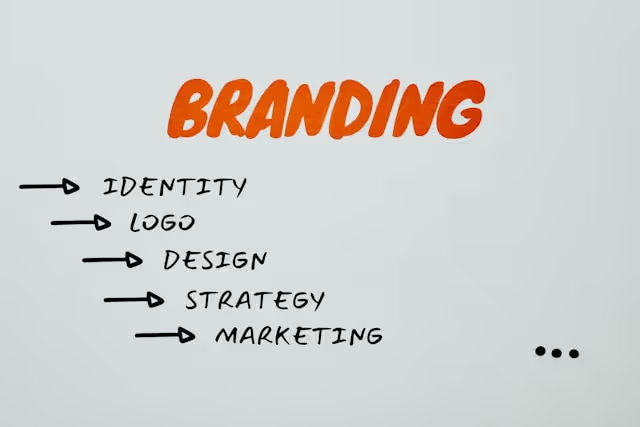Step-by-Step Guide to Creating a Brand Style Guide for Your Healthcare Organization
A brand style guide is an essential tool for healthcare organizations looking to establish a strong and consistent brand identity.


Step-by-Step Guide to Creating a Brand Style Guide for Your Healthcare Organization
Importance of Brand Style Guide
A brand style guide is an essential tool for healthcare organizations looking to establish a strong and consistent brand identity. It provides a comprehensive set of guidelines and standards that ensure consistency across all marketing materials and communications. This section will explore the brand identity overview and the benefits of maintaining consistency through a brand style guide.
Brand Identity Overview
A brand identity is the visual representation of a healthcare organization. It includes elements such as the logo, color palette, and typography choices. These elements come together to create a cohesive and recognizable brand image.
The logo is a fundamental component of the brand identity. It serves as a visual symbol that represents the organization and helps build brand recognition. The brand style guide outlines guidelines for logo usage, including size, placement, and variations. Consistent use of the logo across all marketing materials and platforms ensures that the organization is easily identifiable and reinforces its brand identity.
The color palette is another crucial aspect of the brand identity. Colors evoke emotions and can influence how people perceive a brand. The brand style guide specifies the primary and secondary colors that should be used in marketing materials. Consistency in color usage helps create a unified and visually appealing brand presence.
Typography choices, such as fonts and font sizes, also contribute to the brand identity. The brand style guide provides guidelines for typography, ensuring that the organization's written communications are visually consistent and aligned with the brand's overall image.
Benefits of Consistency
Consistency in branding plays a vital role in establishing trust and credibility for a healthcare organization. When patients and stakeholders encounter consistent branding across various touchpoints, it creates a sense of reliability and professionalism. Consistency also helps reinforce the organization's mission, values, and unique selling points.
A brand style guide facilitates consistency by providing clear guidelines for all marketing materials. By following the guidelines, healthcare organizations can ensure that their brand is represented accurately and consistently across digital and print platforms.
Consistency in branding also leads to better brand recognition. When patients and stakeholders consistently encounter the same visual elements and brand messaging, they develop familiarity and can easily identify the organization. This helps in building brand loyalty and increasing audience engagement.
Moreover, a consistent brand identity simplifies marketing efforts. With a brand style guide in place, healthcare organizations can streamline the creation of marketing materials, as designers and content creators have a clear roadmap to follow. This saves time, reduces errors, and ensures that all communications are on brand.
By investing in a brand style guide and maintaining consistency, healthcare organizations can establish a strong and recognizable brand identity, build trust and credibility, and effectively communicate their message to their target audience.
Elements of a Brand Style Guide
A brand style guide is a crucial tool for maintaining consistency and establishing a strong brand identity for healthcare organizations. It serves as a reference document that outlines the visual and verbal elements that contribute to a brand's overall image. In this section, we will explore three essential elements of a brand style guide: logo guidelines, color palette, and typography choices.
Logo Guidelines
The logo is a visual representation of a healthcare organization's brand. Logo guidelines in a brand style guide ensure that the logo is consistently and correctly used across various applications. These guidelines specify the acceptable variations of the logo, such as color options, placement, size, and clear space requirements.
It is essential to provide clear instructions on how the logo should be used in different contexts, such as on digital platforms, print materials, and signage. By maintaining consistency in logo usage, healthcare organizations can establish a strong and recognizable brand presence.
Color Palette
The color palette plays a significant role in creating a cohesive and visually appealing brand identity. A brand style guide should include a carefully selected color palette that reflects the organization's values, vision, and target audience. It is common to include primary and secondary colors along with their corresponding hex codes or Pantone numbers.
Using consistent colors enhances brand recognition and helps create a unified visual experience across different touchpoints. The color palette should be versatile enough to be used in various applications, including digital marketing materials, print collateral, and branded merchandise.
Typography Choices
Typography choices in a brand style guide ensure that the organization's written communication maintains a consistent and professional appearance. It includes guidelines on font families, font sizes, and font weights to be used for different purposes, such as headings, body text, and captions.
The chosen typography should align with the overall brand image and convey the desired tone. A healthcare organization may opt for fonts that are modern and clean, reflecting trustworthiness and professionalism. The brand style guide should specify the primary and secondary fonts, along with any specific formatting guidelines for headings, subheadings, and body text.
By providing clear guidelines for logo usage, color palette, and typography choices, a brand style guide enables healthcare organizations to maintain visual consistency and reinforce their brand identity across various platforms and materials. Consistency in these elements helps build trust and recognition among patients, employees, and stakeholders.
Voice and Tone Guidelines
In order to create a consistent brand identity for your healthcare organization, it is crucial to establish clear voice and tone guidelines. This ensures that all communication, whether written or verbal, aligns with your brand's values and resonates with your target audience. Let's explore the steps involved in defining your brand voice and maintaining a consistent tone.
Defining Your Brand Voice
Defining your brand voice is the first step towards creating a cohesive and recognizable identity. Your brand voice should reflect the personality and values of your healthcare organization. Consider the following factors when establishing your brand voice:
- Target Audience: Understand the demographics, needs, and preferences of your target audience. This will help you tailor your brand voice to effectively communicate and connect with them.
- Brand Personality: Determine the traits and characteristics that best represent your healthcare organization. Is it compassionate, authoritative, or innovative? Defining your brand's personality will shape the tone of your voice.
- Key Messages: Identify the key messages that you want to convey to your audience. These messages should align with your brand's mission, vision, and values.
- Language Style: Choose the appropriate language style that resonates with your target audience. Consider whether a formal, professional tone or a more conversational, friendly tone is most suitable.
By defining your brand voice, you establish a consistent and recognizable personality that sets your healthcare organization apart from others.
Maintaining Consistent Tone
Consistency in tone is essential to ensure that your brand message is cohesive across all channels and touchpoints. Here are some strategies to maintain a consistent tone:
- Style Guide: Include specific guidelines in your brand style guide that outline the tone you want to maintain. Provide examples and instructions that reflect the desired tone for different types of communication.
- Train and Educate: Educate your team members, including healthcare professionals and marketing staff, on the desired tone and voice guidelines. Conduct training sessions to ensure everyone understands and implements the guidelines consistently.
- Review and Edit: Review all written content, such as marketing materials, website copy, and social media posts, to ensure they align with the established tone. Edit and revise content as necessary to maintain consistency.
- Monitor and Adjust: Regularly monitor your communication channels to ensure that the tone is consistent. Collect feedback from your audience and make adjustments if needed to better align with their expectations.
Maintaining a consistent tone across all communication platforms helps build trust and credibility with your audience. It reinforces your brand identity and fosters a positive perception of your healthcare organization.
By following these guidelines for defining your brand voice and maintaining a consistent tone, you can create a brand identity that resonates with your target audience and distinguishes your healthcare organization in a competitive landscape.
Application Across Platforms
Once you have developed a comprehensive brand style guide for your healthcare organization, it's essential to ensure consistent application across various platforms. Two key platforms to consider are digital marketing and print collateral. Let's explore how to apply your brand style guide effectively in these areas.
Digital Marketing
In today's digital age, a strong online presence is crucial for any healthcare organization. When it comes to digital marketing, consistency in branding is paramount. Here are a few key elements to consider:
- Website: Your website serves as the digital face of your organization. Ensure that your brand's colors, typography, and logo are prominently displayed throughout the site. Consistency in design elements not only creates a cohesive look but also helps build brand recognition.
- Social Media: Social media platforms provide an opportunity to engage with your audience and promote your brand. Incorporate your brand's visual elements, such as the logo and color palette, into your social media profiles. Consistent use of these elements across platforms helps reinforce your brand identity.
- Email Marketing: When sending out newsletters or email campaigns, adhere to your brand's typography and color choices. Use branded templates that align with your brand style guide to maintain consistency in your email communications.
- Digital Ads: Whether it's display ads or paid search ads, make sure to apply your brand's visual and design elements consistently. Align the colors, typography, and overall style with your brand style guide to create a cohesive and recognizable presence.
Print Collateral
While digital marketing is crucial, traditional print collateral still plays a significant role in healthcare marketing. Whether it's brochures, flyers, or posters, maintaining consistent branding across print materials is essential. Here's how to achieve it:
- Logo Placement: Place your organization's logo prominently on all print collateral. Ensure that it follows the guidelines set in your brand style guide, including size, clear space, and color usage.
- Color Palette: Utilize the designated color palette from your brand style guide consistently across all print materials. This includes backgrounds, text, and any visual elements. Consistent use of colors helps establish brand recognition and reinforces your organization's identity.
- Typography: Apply the specified typography choices consistently across print collateral. Use the designated fonts for headings, subheadings, body text, and any other text elements. Consistency in typography contributes to a cohesive and professional appearance.
- Imagery and Graphics: When incorporating images and graphics into your print materials, ensure that they align with your brand's visual style. Use high-quality visuals that reflect your brand's values and resonate with your target audience.
By applying your brand style guide consistently across digital marketing and print collateral, you can create a cohesive and recognizable brand presence. This consistency helps build trust, promotes brand recognition, and enhances your organization's overall marketing efforts.
Creating a Brand Style Guide
Creating a brand style guide for your healthcare organization is an important step in establishing and maintaining a consistent brand identity. It provides guidelines and standards for the visual and verbal elements of your brand, ensuring that all communications and marketing materials are cohesive and aligned with your organization's values and goals.
Research and Analysis
Before diving into the design and implementation of your brand style guide, it's essential to conduct thorough research and analysis. This step involves understanding your target audience, studying your competitors, and evaluating your organization's mission, vision, and values.
Conduct market research to gain insights into your target audience's preferences, expectations, and perceptions. This information will help you shape your brand identity to resonate with your intended audience effectively.
Analyze your competitors' branding strategies to identify gaps and opportunities in the market. By understanding what other healthcare organizations are doing, you can position your brand uniquely and differentiate yourself from the competition.
Evaluate your organization's mission, vision, and values. These foundational elements will serve as the guiding principles for your brand style guide. Ensure that your brand identity aligns with your organization's core values and is consistent with the healthcare services you provide.
Design and Implementation
Once you have completed the necessary research and analysis, it's time to design and implement your brand style guide. This process involves creating guidelines for various visual and verbal elements that make up your brand identity.
Visual elements include your logo, color palette, typography choices, and any other design elements that represent your brand. Create clear guidelines for the usage, placement, and size of your logo across different applications. Define your color palette, specifying primary and secondary colors, and their usage. Select typography choices that reflect your brand's personality and ensure consistency across all communication materials.
Verbal elements encompass your brand voice and tone. Define the tone you want to convey in your communications, whether it's authoritative, compassionate, or informative. Establish guidelines for writing style, including grammar, punctuation, and vocabulary choices. Consistency in tone and voice will help establish a recognizable brand personality and enhance your organization's reputation.
Consider creating a brand style guide document that outlines all the guidelines and standards. This document should be easily accessible to all members of your organization who are involved in creating marketing materials or communicating on behalf of the brand. Regularly update and communicate any changes or additions to the brand style guide to ensure consistency across the organization.
By following a systematic approach of research, analysis, design, and implementation, you can create a comprehensive brand style guide for your healthcare organization. This guide will serve as a valuable resource to maintain consistency in your branding efforts and effectively communicate your brand's message to your target audience.
References
https://venngage.com/blog/brand-style-guide/
https://creativesoncall.com/insights/how-to-build-strong-healthcare-brand-guidelines







